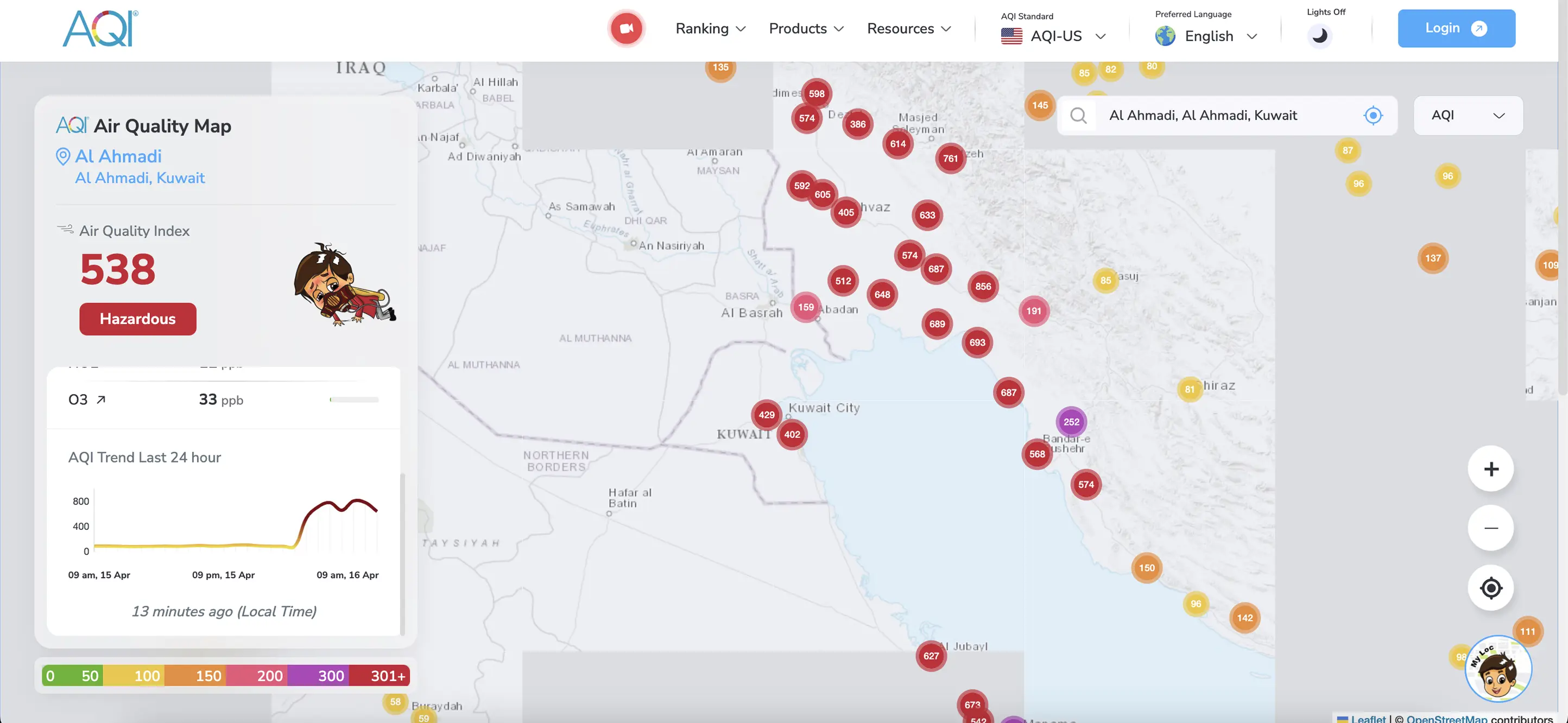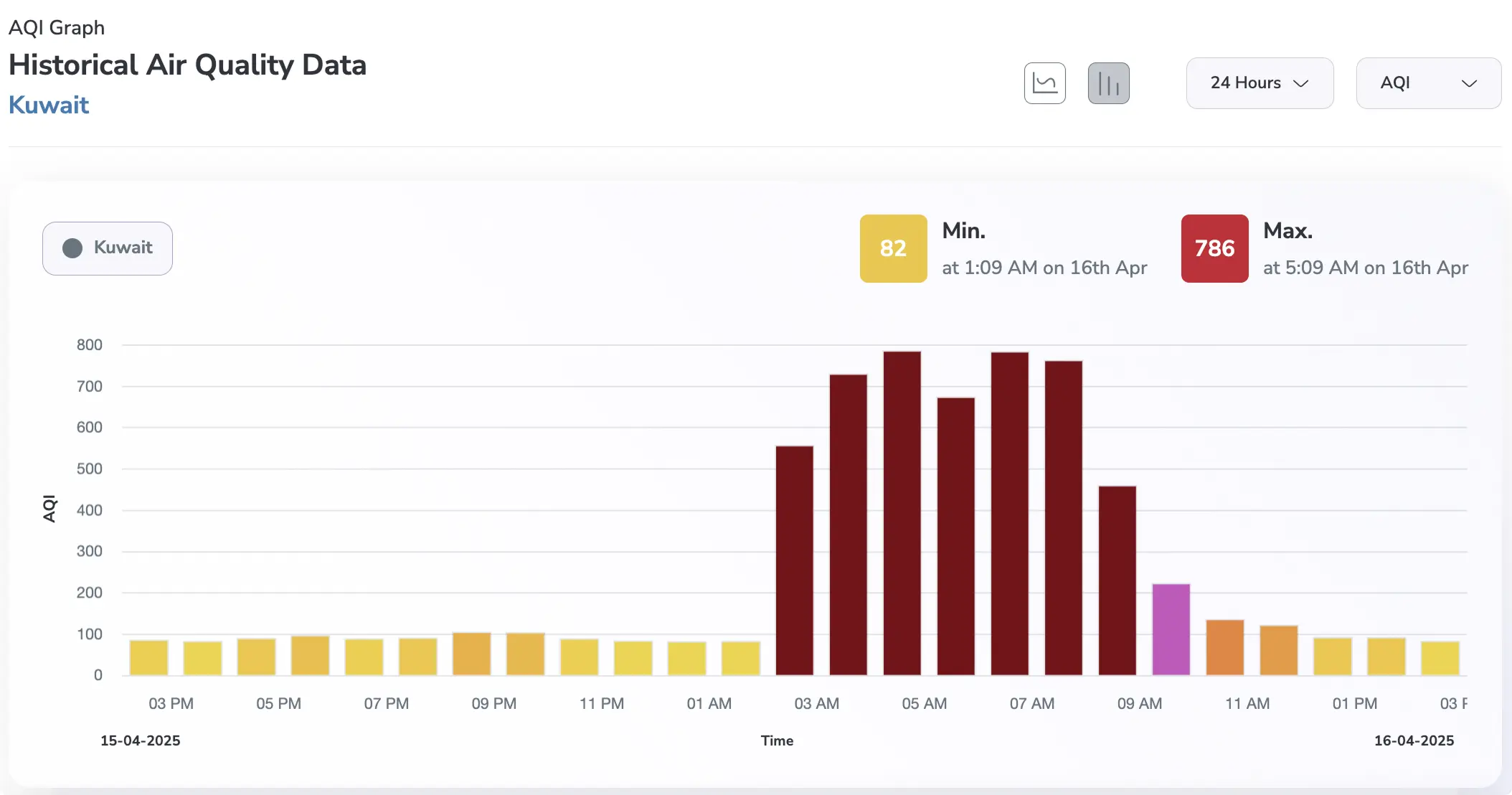Dust storms have recently hit Kuwait, Iraq, and Saudi Arabia, making the air very unhealthy to breathe. In Kuwait, the air quality index (AQI) in Al Ahmadi reached 538 and 502 in Al Qurain, both considered hazardous levels as a result. Read on to know how recent dust storms affect air quality in the Middle East.
It happens because these storms carry tiny, harmful particles called PM10 and PM2.5, which pollute the air and can cause serious health problems. For example, in Al Khobar, Saudi Arabia, PM10 levels went up to 442 micrograms per cubic meter (µg/m³), which is much higher than what is considered safe.
Historical Conditions of Dust Storms in the Middle East
Dust storms have been a long-standing problem in the and have been getting worse over time, especially in Gulf countries. In 2022, strong storms caused breathing problems for many people in Iraq, leading to over 5,000 hospital visits. These storms also hurt the economy, costing the region about $13 billion each year by damaging farms, buildings, and property. In cities like Riyadh, there were more than 35 days with dust storms in early 2022, showing how often they disrupt daily life.
Severe Dust Storm Affected Air Quality in the Middle East
A large dust storm has caused the air quality to worsen in parts of Iraq, Iran, Kuwait, and eastern Saudi Arabia. And also in Gulf states like Bahrain and Qatar. As a result, the Air Quality Index (AQI), which usually remains in the “good to poor” category, has gone up to dangerous levels in many places. Some areas, like near southern Iraq, even recorded an AQI of 856, and moreover, coastal regions showed 693, both far above the safe limit.

Cities like Kuwait City and Dammam now have AQI levels over 600, meaning the air is extremely polluted. The high AQI is due to dust and tiny particles in the air, which can be very harmful, especially for people with breathing problems, older adults, and children. Health officials are likely telling people to stay indoors as much as possible until the air improves.
Current Air Quality Data (April 16, 2025)
The blog post provides detailed of how dust storms affect air quality in the Middle East on April 16, 2025, indicating hazardous conditions:

| Location | AQI | Category | PM10 (µg/m³) | PM2.5 (µg/m³) |
| Al Khubar, Saudi Arabia | 534 | Hazardous | 442 | 1210 |
| Khuzestan, Iran | 770 | Hazardous | 559 | 189 |
| Al Ahmadi, Kuwait | 807 | Hazardous | 577 | 144 |
| Dammam, Saudi Arabia | 672 | Hazardous | 510 | 230 |
| Doha, Qatar | 356 | Hazardous | 352 | 88 |
| Manama, Bahrain | 293 | Severe | 385 | 91 |
Recent Dust Storm Activity in the Middle East:
Dust storms in the region started getting worse around April 14, 2025. On that day, Kuwait was hit by a major storm that made it hard to see across the country. Authorities warned people, especially those with breathing problems, to stay indoors.

On April 15, Iraq was hit by a strong sandstorm in the central and southern areas. As a result, visibility dropped to less than 1 kilometre, and airports in Najaf and Basra were forced to close. The storm caused over 1,000 people to have breathing problems, including 700 cases in Muthanna, 250 in Najaf, 322 in Diwaniyah, and 530 in Dhi Qar and Basra.
In Iran’s Khuzestan province, dust from Iraq and Saudi Arabia caused very dangerous conditions. A red-level alert issued on April 15, with PM10 levels 67 times higher than the safe limit. About 20 people were hospitalized in Ahvaz and Hamidiyeh, and 19 cities were reported to have hazardous air quality.
The UAE was also affected on April 15, with dusty winds reaching speeds of 40 km/h and visibility dropping below 1,000 meters.
How Governments Are Responding to the Dust Storms in the Middle East?
Countries hit by the dust storms are taking steps to keep people safe:
- Working and Learning from Home: In some places, like Iran’s Khuzestan province, schools and government offices told people to stay home and work or study online. This helps people avoid breathing in the dirty air.
- Health Warnings: People have been warned to stay indoors, especially those with asthma, breathing problems, the elderly, and children.
- Travel Problems: Dust storms caused airports in cities like Najaf and Basra to close. This has made travel difficult and hurt business in the area.
Experts say these storms are getting worse because of climate change. That’s why it’s important to check air quality often and tell people quickly when it becomes dangerous.
Conclusion
The Gulf region is facing a serious air quality crisis. Dangerous levels of dust and harmful gases are making the air unsafe to breathe in many cities. As more people report breathing problems and AQI levels stay high, it’s clear that action is needed right away, and long-term solutions are also important.
Both local people and leaders must get ready for more of these extreme weather events as the climate continues to change. Staying updated with trusted news and following health warnings are the best ways to stay safe during this time.